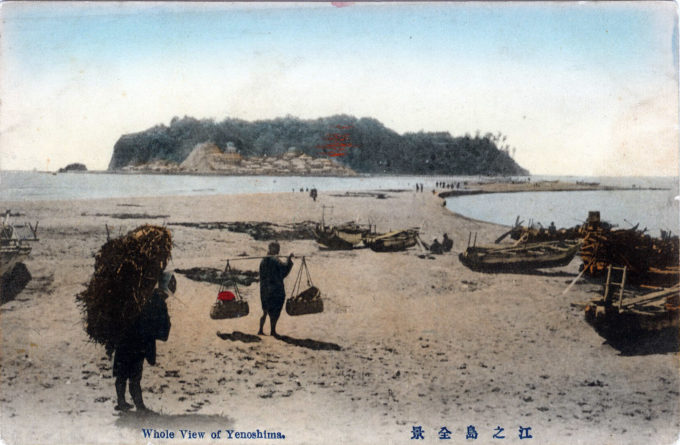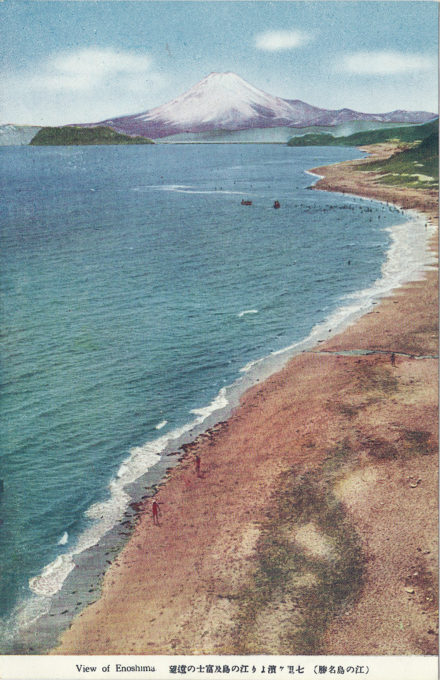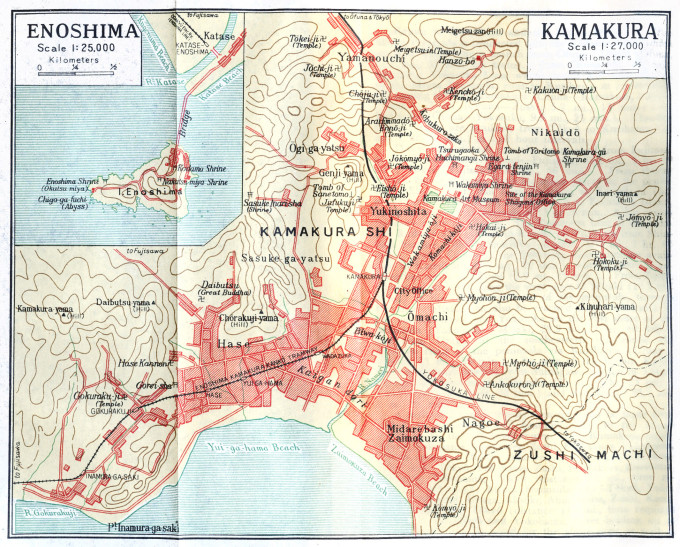
“Whole view of Yenoshima”, c. 1910. Before a causeway bridge was constructed, a visit to Enoshima could be made only at low tide.
See also:
Katase Beach, Enoshima, 1910-1960.
Enoshima, c. 1910-1960.
Kinkiro Hotel, Enoshima, c. 1910.

“View of Enoshima” in the upper left, Hearn’s “beautiful high green mass”, with Mt. Fuji in the distance, c. 1930.
“And our path turns sharply to the right, and winds along cliff-summits overlooking a broad beach of dun-colored sand; and the sea wind blows deliciously with a sweet saline scent, urging the lungs to fill themselves to the very utmost; and far away before me, I perceive a beautiful high green mass, an island foliage-covered, rising out of the water about a quarter of a mile from the mainland.
“Enoshima, the holy island, sacred to the goddess of the sea, the goddess of beauty. I can already distinguish a tiny town, grey-sprinkling its steep slope. Evidently it can be reached to-day on foot, for the tide is out, and has left bare a long broad reach of sand, extending to it, from the opposite village which we are approaching, like a causeway.
“At Katase, the little settlement facing the island, we must leave our jinricksha and walk; the dunes between the village and the beach are too deep to pull the vehicle over. Scores of other jinricksha are waiting here in the little narrow street for pilgrims who have preceded me. But to-day, I am told, I am the only European who visits the shrine of Benten.”
– Complete Works of Lafcadio Hearn, edited by Delphi Classics, 2017

View from Enoshima at low tide, c. 1930, looking toward Fujisawa (Katase) after construction of the causeway bridge sometime in the 1920s.
“No better advice could be given to a traveller new to Japan than this: Go to Enoshima, the ‘picture island,’ and, if you can, stay there for several days! Easy of access from either Yokohama or Tokyo, it nevertheless can supply the newcomer to this wonderful country with more delightful and novel experiences than any other place I know of.
“Most people know of Kamakura and spend at least a day there , but I had never realized that Enoshima was but a short half hour away by trolley line from the station where one gets out to visit the great Shrine of Hachiman and the famous Daibutsu … As the tram rounded a curve I , who was standing hanging on to a strap of the much over-crowded car, was shoved forward so that I looked out of the window towards the West.
“I gasped. There was Fuji-san clear and perfect against a sky beginning to color with sunset tints! Also there was Enoshima tethered to the shore by its spindling bridge and on the beach beneath the track of the trolleys glorious breakers were curling their crests over into foam. I wanted to descend and run, impatient of the car’s slow progress toward Katase, which is where one gets out to go to the picture island, but I knew I would arrive there more surely in the end by staying on it.”
– Visits to Enoshima, by Virginia Lee Welch, The Tourist, January 1920


